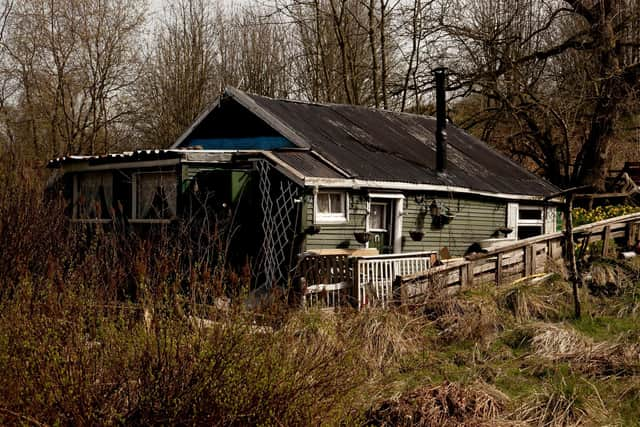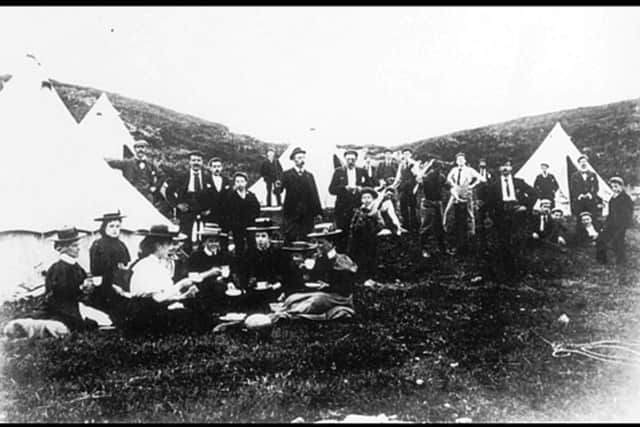Love shacks: how Covid has sparked new interest in hutting
Scotland's most famous hutting community – at Carbeth, near Strathblane in Stirlingshire – has been experiencing a jump in the number of people enquiring about ‘off-grid’ boltholes.
Chris Ballance, chair of the Carbeth Hutters community company, believes the Covid-19 crisis has made people re-evaluate what’s important and seek out the well-being boons of getting outside.
Advertisement
Hide AdAdvertisement
Hide Ad“Interest in hutting has grown to a huge extent over the past year,” he said.
“Whereas we used to get about one enquiry every five weeks or so, over the last few months we have been seeing more like five a week.
“It’s partly because there have been more people out walking - the John Muir Way and West Highland Way both pass through Carbeth – and because we have now put up signage around the estate.
“But mainly I think it’s because more people are seeing the benefit of the outdoors and there is a growth in interest in living closer to nature, away from the concrete and tarmac of city life.”
The Carbeth Hutters community has roots dating back almost 100 years, beginning when soldiers returning from action in the First World War were granted camping rights by the then landowner Allan Barns Graham.


In later years families based in heavily industrialised areas around Glasgow would head to the site for fresh air and tranquility, surrounded by trees, hills, lochs and wildlife.
Numbers peaked during the Second World War, after nearby Clydebank was devastated in an air raid in 1941. The huts filled with evacuees and homeless families, with many workers trekking daily across the Kilpatrick hills to their places of employment.
Numbers dwindled over the following decades.
Prior to the community buyout in 2010, there were more huts available than people wanting to have one.


Advertisement
Hide AdAdvertisement
Hide AdNow, though, there is a waiting list – despite a number of new huts being built over the past decade, bringing the current total to around 170.
The Thousand Huts initiative, run by environmental charity Reforesting Scotland, successfully campaigned to get Scottish planning laws and building regulations changed to encourage the hutting tradition.
Karen Grant, from Thousand Huts, said: “More than ever, there is a need to find peace - a step away from the incessant mental clamour of modern life.
“We would all benefit from a better connection to nature. Huts are one way to make this happen.


“People in Scotland can enjoy access to simple huts in nature, just as the Scandinavians do.
“Some of the barriers to new hutting have been removed, but some, like affordable access to land, still remain.
“Achieving our own huts will still need a power of work. But hopefully, if we work together, it should be fun.”
Lee Paton and her brother Ross own a 670-acre dairy farm near the village of Auchencairn in Dumfries and Galloway.
Advertisement
Hide AdAdvertisement
Hide AdThere were five huts on the site when their father bought the land in the 1940s, with all but one eventually torn down after being abandoned in the 1960s.
Today there are once again five, including Ms Paton’s own.
“All my life I have wanted to recreate a hut site on the farm and so I was very Interested when I heard about the Thousand Huts campaign and the changes made to Scottish planning policy,” she said.
“I attended the Hutters Rally in Kirkcaldy in 2016 and came away from there feeling very excited and a bit nervous at the realisation that a new hut site was a distinct possibility.
“I still wonder sometimes how I got from there to here, but I knew at the start it would be one small, slow step at a time.
“By 2020 we were almost a new hut community, with hutters from Lancaster, Carlisle, Dumfries, Gatehouse, Castle-Douglas and Kirkcudbright.
“Covid has called a halt to most hutting activity in the past year but we are all desperate to resume as soon as we can.”
Huts are not intended as full-time residences. They do not have foundations, and the internal floor area can span no more than 30 square metres.
Hutters usually rent a plot of land on an annual lease, but must buy or build their own hut.
Advertisement
Hide AdAdvertisement
Hide AdThe tiny dwellings are not connected to utilities, with no electricity, running water or traditional toilet facilities. Many rely on solar power or batteries for lighting and wood stoves for heating and cooking, while water must be carried in.
And it seems this rustic charm is behind their appeal.
According to Mr Ballance, expanding hutting opportunities could also benefit the environment.
“We have now had to close our waiting lists as it is likely anyone being added to them now would have to wait several years for a hut,” he said
“There is very definitely more demand for huts across Scotland than there is land being made available for them.
“There is a clear need for much more reforesting of Scotland, and huts fit well with mixed woodland, providing an income while developing woodland on marginal land.”
If you fancy joining the off-grid revolution, you can find detailed information and inspiration on the Thousand Huts website.
To hear more about hutting, listen in to the second episode in The Scotsman’s Sustainable Scotland podcast series, being broadcast on Thursday 21 January